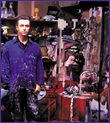
calum colvin
explores dimensions myth & truth of
by Carol Pope
Journalist Alastair McKay tells a good story about taking a Calum Colvin print, cleverly centred around a bathroom mirror, to be framed. The assistant turned from filling in the form, glanced at the carefully constructed visual puzzle, layered with images and meaning in the way only Colvin can. He hesitated only momentarily above the subject box before penning in 'sink'.
Following the huge success of his work on Burns the leading contemporary Scottish artist and graduate of Duncan of Jordanstone College has turned his attention to another more ancient figure from Scotland's literary past - Ossian.
'The fluidity of historical knowledge and the enigma of memory' is the phrase Calum Colvin uses to describe the theme of his most recent work which goes on show in the Scottish National Portrait Gallery in October this year. Another descriptor he uses is 'apocalyptic'.
Titled 'Fragments of Ancient Poetry' it draws on the poems of Ossian and James Macpherson's blend of fact and fiction in his eighteenth century account of ancient Celtic mythology. Using the largely forgotten but once hugely influential text of Ossian as a foil for investigating truth and myth, Colvin explores his enduring preoccupation.
We meet in winter in Dundee when work is still in progress and under wraps in his Edinburgh studio. He's quite prepared to talk about it but not, at this stage, to expose it to public view. Darkly constructed and melancholic are among the terms he uses to describe 'Fragments' but, he reassures, 'it didn't start out like that'.
In an extraordinary way 'Fragments' has echoes which reverberate right back to Colvin's student past when the crumbling derelict buildings of the older parts of Dundee cast a spell over him. 'I wandered the streets for hours at a time, looking for striking images to photograph.' 'Fragments' involves him physically working with breezeblock, quite literally cutting into stone, just as he first learned to do in sculpture classes at the College. Chunks of rubble, exactly the kind of thing that fascinated him down the Dundee days, are - he says - a key feature; while references to aspects of Scottish culture litter the photographic set. These are mostly paintings based on Ossian myth and fragments of everything from Robert Burns and Walter Scott to Callum Kennedy.
'It's about the survival of culture in the twenty-first century and the notion of myth and national identity as an enduring concern.'
That quest for the defining icons of Scottish identity and culture has made a shameless scavenger of the artist. He's as likely to find his source of inspiration in skips and bins as on beaches and building sites. Old post cards, seventies junk novels, shards of wood and rubble might easily take his fancy for immortalisation in art. Sacred Ibis (1985) truth
But that other question too persists in his mind. The relationship between fact and fiction, truth and myth, reality and memory - the blurring of the lines. And in one sense his new art of digital photography could not be a more apposite medium to explore this.
When and how does myth mutate into fact - has real parallels with what is happening here and now with photography. Not so long ago a photograph could be relied upon as capturing a real moment in time. A visual fact pinned to the board. No more. The coming of digital photography and its image enhancing box of tricks has the capacity to morph reality. Colvin regards this time as a fundamental watershed in photography.
'In the future we will refer to the ages of pre digital and post digital photography in much the same way as archaeologists date periods. Suddenly with digital imagery the notion of truth in photography comes under question.' Calum Colvin took up a new Chair of Fine Art Photography at his old college, in October 2001, just less than twenty years after his graduation.
Colvin, who was born in Glasgow, joined Duncan of Jordanstone as a student in 1978, laying the foundations for his career studying sculpture and photography. After graduating, he specialised in photography at the Royal College of Art in London.
Colvin's rare approach is to assemble a tableau of objects - many of them everyday domestic kitsch - which are then painted and photographed. His works, which include well known pieces such as Sacred and Profane and the Kelvingrove Eight are internationally renowned, widely exhibited, and held in many public collections including the Art Institute of Chicago and the Scottish National Portrait Gallery in Edinburgh.
Next page
| 
